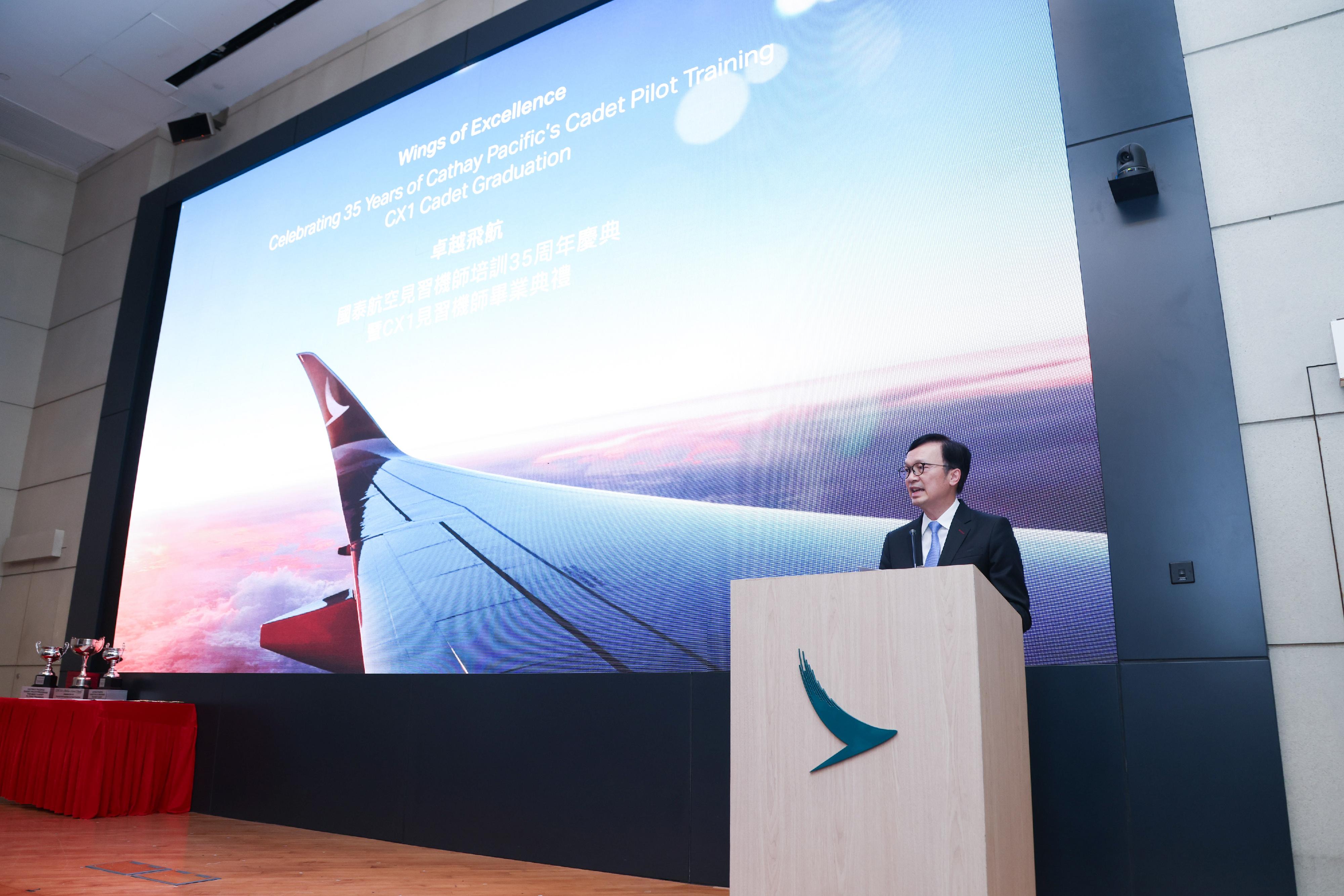Speech by Acting STL at Cathay Pacific Cadet Pilot Programme graduation ceremony (English only) (with photo)
Following is the speech by the Acting Secretary for Transport and Logistics, Mr Liu Chun-san, at the Cathay Pacific Cadet Pilot Programme graduation ceremony today (December 5):
Ronald (Chief Executive Officer of Cathay Group, Mr Ronald Lam), Captain Kempis (Director Flight Operations of Cathay Pacific (CX), Captain Chris Kempis), Mr Burns (General Manager Flying of CX, Mr Tim Burns), Professor Man (Dean of Faculty of Engineering of the Hong Kong Polytechnic University (PolyU), Professor Man Hau-chung), Mr Davidson (Chief Executive Officer of Aeroguard Flight Training Center, Mr Joel Davidson), Captain Wong (Chief, Flight Standards of the Civil Aviation Department, Captain Lawrence Wong), distinguished guests, ladies and gentlemen,
Good afternoon. It is my great pleasure to be here today to witness another batch of cadets graduating from the well-esteemed Cathay Pacific Cadet Pilot Programme.
Building on its 35-year legacy of nurturing local cadet pilots, the CX Cadet Pilot Programme has been continuously enhanced to provide high-quality and professional training for our pilots-to-be. Today's event marks another important milestone for the Programme, as this graduation ceremony is for the first cohort of cadets who graduated from the new integrated course developed by CX and PolyU. Unlike the legacy course, where theory, flying as well as simulator training are all conducted in Australia, this new integrated course offers an alternative mode of training for prospective pilots, which includes theoretical ground training at PolyU and multi-crew simulator training at Cathay City.
Here, I would like to thank CX and PolyU for your commendable efforts in exploring new options to attract new blood into the aviation industry and enriching the capacity of aviation professional training in Hong Kong. To enhance Hong Kong's strategic position as an international aviation hub in accordance with the National 14th Five-Year Plan and the Greater Bay Area Outline Development Plan, the Government has attached great importance to manpower training. Promoting localisation of the aviation workforce is one of our major policy objectives, and local airlines and education institutions have been playing an indispensable role on this. That said, we clearly understand that it requires collaborative efforts to maintain a competent and high-quality workforce to support the growth and development of the aviation industry.
The Government spares no effort in attracting and grooming aviation talent. The solid recovery of the aviation industry post-pandemic, as well as the major airport development projects in the pipeline, has led to growing demand for aviation manpower. The Government has been working together with the Airport Authority Hong Kong (AAHK) and the industry to take a range of measures to address the manpower shortage issue.
On the one hand, in order to address short- to medium-term manpower shortage, we launched the Labour Importation Scheme for the Transport Sector – Aviation Industry in July this year, to allow the industry to import workers to fill vacancies for airport frontline non-supervisory positions under 10 specified job types, on the premises of local employment first. A total of 2 800-plus quotas were approved in the first round of application and imported workers have been arriving in Hong Kong since October.
As for long-term manpower demand, which will have to be met by the local workforce, the Government and the AAHK have together adopted a three-pronged strategy to attract new blood and retain talent.
Firstly, the AAHK has been stepping up local recruitment effort by co-organising large-scale job fairs with the Labour Department and trade unions.
Secondly, various measures have been adopted to improve the working conditions of airport staff, including launching an airport staff pooling scheme and introducing automation technologies to improve airport operations and reduce work pressure on frontline staff; reducing commuting cost both in terms of time and money for airport staff by the AAHK's subsidy for bus companies to increase airport bus frequency and a new transport subsidy scheme for airport staff to be rolled out in due course; as well as the AAHK's development of the HKIA Community Building to improve staff welfare by providing leisure, catering and nursery facilities for all airport staff.
Thirdly, training for airport staff will be stepped up through the Government's continual support under the Maritime and Aviation Training Fund and the courses provided by the Hong Kong International Aviation Academy. The Government will continue to monitor the labour market situation and adopt a multipronged approach to address the manpower needs of the aviation industry.
In closing, may I congratulate all 21 graduates here today on completing the CX Cadet Training Programme. Today, you embark on a new journey into the world of aviation. May your passion and professionalism propel you to new heights in your career. Last but not least, I would like to remind that the District Council election will be held on the coming Sunday. Let us cast our vote for a better community that belongs to everyone including all of you. Thank you.
